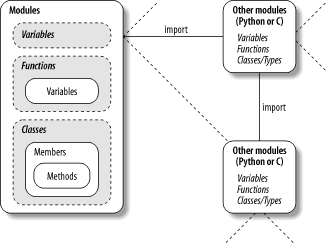| [ Team LiB ] |
|
18.6 Module Design ConceptsLike functions, modules present design tradeoffs: deciding which functions go in which module, module communication mechanisms, and so on. Here are a few general ideas that will become clearer when you start writing bigger Python systems:
As a summary, Figure 18-1 sketches the environment in which modules operate. Modules contain variables, functions, classes, and other modules (if imported). Functions have local variables of their own. You'll meet classes—another object that lives within modules—in Chapter 19. Figure 18-1. Module environment 18.6.1 Modules Are Objects: MetaprogramsBecause modules expose most of their interesting properties as built-in attributes, it's easy to write programs that manage other programs. We usually call such manager programs metaprograms, because they work on top of other systems. This is also referred to as introspection, because programs can see and process object internals. Introspection is an advanced feature, but can be useful for building programming tools. For instance, to get to an attribute called name in a module called M, we can either use qualification, or index the module's attribute dictionary exposed in the built-in _ _dict__ attribute. Further, Python also exports the list of all loaded modules as the sys.modules dictionary (that is, the modules attribute of the sys module), and provides a built-in called getattr that lets us fetch attributes from their string names (it's like saying object.attr, but attr is a runtime string). Because of that, all the following expressions reach the same attribute and object: M.name # Qualify object. M.__dict__['name'] # Index namespace dictionary manually. sys.modules['M'].name # Index loaded-modules table manually. getattr(M, 'name') # Call built-in fetch function. By exposing module internals like this, Python helps you build programs about programs.[1] For example, here is a module named mydir.py that puts these ideas to work, to implement a customized version of the built-in dir function. It defines and exports a function called listing, which takes a module object as an argument and prints a formatted listing of the module's namespace:
# A module that lists the namespaces of other modules
verbose = 1
def listing(module):
if verbose:
print "-"*30
print "name:", module.__name__, "file:", module.__file__
print "-"*30
count = 0
for attr in module.__dict__.keys( ): # Scan namespace.
print "%02d) %s" % (count, attr),
if attr[0:2] == "__":
print "<built-in name>" # Skip __file__, etc.
else:
print getattr(module, attr) # Same as .__dict__[attr]
count = count+1
if verbose:
print "-"*30
print module.__name__, "has %d names" % count
print "-"*30
if __name__ == "__main__":
import mydir
listing(mydir) # Self-test code: list myself
We've also provided self-test logic at the bottom of this module, which narcissistically imports and lists itself. Here's the sort of output produced: C:\python> python mydir.py ------------------------------ name: mydir file: mydir.py ------------------------------ 00) __file__ <built-in name> 01) __name__ <built-in name> 02) listing <function listing at 885450> 03) __doc__ <built-in name> 04) __builtins__ <built-in name> 05) verbose 1 ------------------------------ mydir has 6 names ------------------------------ We'll meet getattr and its relatives again. The point to notice here is that mydir is a program that lets you browse other programs. Because Python exposes its internals, you can process objects generically.[2]
|
| [ Team LiB ] |
|